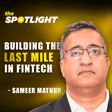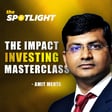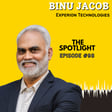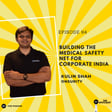Become a Creator today!Start creating today - Share your story with the world!
Start for free
00:00:00
00:00:01

How Harkunwar is building a $40mn ARR Edtech with just $1mn funding
Discover how Harkunwar recognized the gap between traditional architectural education and industry demands, leading him to establish Novatr, a trailblazer in equipping students with cutting-edge skills. Novatr is not only revolutionizing architectural education but also achieving remarkable sustainability, aiming for an impressive ARR of $40 million with just $1 million in funding. Tune in to explore the journey of building a sustainable Edtech business in a rapidly evolving industry landscape.
Get notified about the latest releases and bonus content by subscribing to our newsletter at www.founderthesis.com
Transcript
Introduction to Har Kumar and Novator
00:00:00
Speaker
I'm Har Kumar, co-founder and CEO at Novator.
00:00:09
Speaker
So HK, as your friends and people who know you call you, give me a like an elevator pitch of Novator.
Cohort-Based Learning vs. Self-Based Learning
00:00:17
Speaker
At Novator, we are building online cohort-based courses for architects, engineers, and designers so that they can advance in their professional growth. Let's unpack it a little bit. So cohort-based is as opposed to self-based. So cohort-based means that there will be a bunch of 50 or 100 or certain number of students who start a batch together. It's going to be like the way we have batches in offline world, similar to that, except it's online.
00:00:44
Speaker
Yes, yes, totally. So cohort is to do with a specific start time, a specific end time. And that creates a controlled environment where learners are supposed to do work, get it done. you know It helps in closing for the procrastination usually we do while learning on a self-paced program. And it also creates a space where a more synchronous learning can happen, where people can interact with each other live. There is a common time we work together to learn. So that's that's the advantage of doing the cohort-based learning.
00:01:14
Speaker
and Right, right. the The learning from peers is ah probably more valuable than anything else, at least from what I remember during my ah B-School days. And what are the courses that you offer?
Courses Offered by Novator
00:01:28
Speaker
So we currently offer courses in two specific technologies, I would say. One is BIM, building information modeling, and the other is computational design. And we we offer these programs for architects, civil engineers. And we do enroll mechanical and electrical engineers as well. However, we are coming up with a purely focused program on that category as well.
00:01:53
Speaker
Help me understand what is, ah you are in the space of construction then, broadly speaking. what is ah What goes on when a building is getting constructed? What are the different parts of it? Because you spoke of BIM and computational design. and To an outsider, they seem exactly the same. What is the difference?
00:02:15
Speaker
got it. So let's pick up, you know, when when any building or infrastructure, when I say infrastructure, a assume things like highways, roads, bridges, ah some sort of urban scale development, all this is part of infrastructure and buildings as ah also part of it.
00:02:33
Speaker
so When we look at any development that happens, it goes through high level four phases and there are more technical complexities to it, but I'll break it down into four broad phases, which everyone can understand.
Construction Process Phases
00:02:46
Speaker
Any development starts with surveying, like you survey the site, the land where something has to be built, soil condition, et cetera, et cetera. And apart from that, straight away, we get into the next phase, which is about designing, designing and scoping out what has to be built, how exactly the entire design is going to be put together, and also breaking ah down into how execution of construction is going to take place.
00:03:13
Speaker
So there is a term called GFC we create by the end of it good for construction drawing the other set and then it moves into the phase of you know construction where on site building construction actually happens whether we are you know whatever the project is on to there's an entire phase of how the construction is going to take place and it's not limited to what's happening just in that particular you know site, it hampers you know some sort of a context as well. If suppose a metro station is going to be built, it's going to hamper a lot of other parts of the day-to-day movement of people. So even traffic engineers get involved, and many other things are a part of how construction is going to take place. And then eventually, once the construction is completed and things come together,
00:03:56
Speaker
ah we move on to the fourth phase, which is operating and running an infrastructure. So you know evaluating energy consumption, water consumption, all parts of it, and how day-to-day running is happening for the infrastructure build. So these are the broad level four phases of a construction process.
00:04:18
Speaker
Where does Bayman computational design fit into this?
Digitalization in Construction
00:04:23
Speaker
All right, so talking about BIM and computation, let's let's just narrow down, you know, I discussed just four phases. BIM and computation are the new technologies which, you know, talk about digitalization of things within the certain parts of the process, but let's Let's go back a bit like how they used to actually happen. When we used to look at surveying for decades, surveying has always happened through things like total stations or doing a lot of hands-on groundwork to survey the topography of a land.
00:04:57
Speaker
and you see right like suddenly this has evolved surveying has entirely evolved into things like GIS geographical you know information systems or GPS you know how we map geography overall or there are you know more new technologies that I've come in.
00:05:14
Speaker
Apart from that, as you move further into design process. If we are talking about some sort of complex design that has to become together, which is more efficient optimized more sustainable, you know.
00:05:29
Speaker
Usually we we used to put in a lot of hours, manners into doing a lot of analysis, evaluating data, and probably it would take months and years. And in today's day with computation, you can feed in algorithms and data and come up with simulations of design.
00:05:45
Speaker
that you know the form can be more optimized like this or the building's orientation or the form can be optimized to create, you know make sure it has more daylight or lesser energy consumption due to sun, et cetera, et cetera, or probably you know structural analysis as well that in this seismic zone with you know this sort of ah intensity of earthquakes happening in the zone, this is how it was more structurally stable. And that all analysis which would initially take probably months can now be broken down into days and hours, actually. And you can come up with a lot of simulations, compare them and say, this is how it should be done. Similarly, in the entire execution, what is what is this called this simulation?
00:06:27
Speaker
these This is all under the subset of using computation to come up with designs. Now, sustainability or, you know like for example, the cars you see in today's day, the fluidic designs, they are optimized for you know dynamism with respect to air and wind. And how you optimize that form, it's a lot of computation that goes into it. Or probably you know the shoes that in today's day Nike or Adidas produces, how can it add to the movement of humans? It's all led by computational design.
00:06:56
Speaker
So it's from buildings to a shoe to a furniture, everything it can be used to optimize. and doing this so So computational design is doing a like a digital twin of the building, within ah which is interacting with the environment so that the design can be optimized based on how it responds and reacts to the environment and the other factors in it. and okay and Yeah, yeah. yeah so So there is more to digital twin. I'll probably get back to that once I pick up the subject of them with you. um So to put you together, like look at the construction phase, we usually traditionally we would have paper drawings, we would, you know, organize things through a lot of coordination over organizing Excels, etc, etc, or over phone calls, video calls, what's happening, we will put together those paper drawings and take it to site.
00:07:52
Speaker
Before I narrow down, let me also get a step back. Let's look at a big building, a 10 story building has to be built. You know, on an average, a typical building has close to 20 different specialized consultants working on that building to make that come to life.
00:08:08
Speaker
There is someone looking at you know electrical, someone looking at, you know obviously it starts with architecture, moves into similar structure engineering, electrical, mechanical engineering comes in to look at heat ventilation, air conditioning of the building. There is someone who's coming in as a fire technician, someone who's coming in for various reasons. And when 20 of these have to collaborate on a project,
00:08:31
Speaker
It makes it very, very difficult for all of them to make sure everything is coming together well. And what happens? They all break down things on certain base drawings or base work that has been done. But when actually the building starts coming together, there is so much of conflict.
00:08:47
Speaker
but Okay, you know we have put together water pipes over here, but the duct for the wind has to come over here. So the air has to come over here. So how do we narrow this
Optimizing Construction with BIM
00:08:56
Speaker
down? And suddenly there is so much of breakage and then assembling it and time that goes along with it. That's what makes the construction process very tedious. Now with that auction of big,
00:09:07
Speaker
This entire process is becoming digital. you Basically, when you design something, you have made a digital model. that Then that model is ah you know extracted into information. BIM is about you know information, data, and information management.
00:09:23
Speaker
So everything is as a data point, whether it's measurements, whether it's textures, whether it's color, whatever specification you put in, it's all a data point. And you start making a digital twin of that building that you're going to construct. And all these consultants that I just mentioned, 20 of them, they start collaborating on that digital model to make that thing very, very clean,
00:09:48
Speaker
you know resolve and everything in place. And to give you an idea, as soon as a digital twin is infused and you know we start putting in something called class detection, how many classes does a building has when everyone's work is you know put together on a model. It comes with 2,000, 3,000 classes and that's where AI is being integrated.
00:10:07
Speaker
And then suddenly you keep resolving, you take a few weeks, a few months to resolve on pressure and then start construction and move into that part of the construction. And it eventually leads to you saving years on that entire construction execution. And and that's what the process of business and build and extra twin has not limited to construction process alone. It also plays a very pivotal role in operating and maintaining the building in a much efficient and better manner because everything is now data and information.
00:10:38
Speaker
Okay. Okay. Understood. interesting Interesting. If I was to compare it with building a, let's say building a mobile app. So the UI UX design, what a product manager does, you know, the the flows, the UI UX design would be computational design and what probably the tech team does in terms of the microservices and the APIs and the integrations and the whole backend architecture is what happens in the BIM phase.
00:11:02
Speaker
so Product managers are responsible for the relevant output, but it's product designers who get involved in the UI UX and intuitive experience of the product entirely. So architects and designers are the ones who are looking at the computational design front of that.
00:11:20
Speaker
All sorts of engineers are looking at BIM, etc, and all those parts. And imagine a product manager similar to in the construction industry, someone who's a construction manager or a project manager. And they are the ones who are coordinating from design to delivery to all the parts in between to make the desired outcome come to life. So the BIM is primarily run by the project manager.
00:11:43
Speaker
Yeah. So there are project managers who are, I'm how everything is organized and various engineers working onto it, having an understanding of Ben and their specialized skill to integrate everything in that. Okay. Understood.
00:11:56
Speaker
um Now, you know, there are different levels of but learning a skill. If I was to make a career in finance, I could ah go and do a course in Tally, ah which would teach me basics of accounting and how to use Tally for bookkeeping, or I could do a CA, or I could do a CFA. And, you know, I mean, the the value add is correspondingly higher, where would a BIM course fall in this hierarchy or a computational design course fall in this hierarchy?
Novator's Software Tools and Curriculum
00:12:29
Speaker
So a typical program that we have put together does cover close to 15 to 20 softwares but the core focus is on workflows.
00:12:37
Speaker
How, you know, as a computational designer, you would be evolving from a design that you have put together to a BIM workflow end to end and actually be a part of the entire chain of the things. And similarly, we have identified some of the top companies of the world which are into construction, infrastructure, architectural design, all these.
00:12:58
Speaker
We identified like you know there are these unique flow workflows that they have put together that makes the entire process so much better and faster. And those workflows have been integrated as the part of the curriculum and the course, and we are close to 21 of them as part of the course. And that basic basically makes you really capable to go out there and be of value to any organization where you will be. Give me an example of what a workflow would be like.
00:13:24
Speaker
A workflow would be something, you know, so there is a scope or a design concept that we are putting together now. we We have narrowed it down that you know this is the design final design what we want. Now the process is we scope scope it out a brief that it needs to have these many be you know rooms of ah meeting rooms, these many conference rooms, these many workstations, et cetera, et cetera. And that evaluates, like comes out as a design. Now design, apart from functional needs, has to solve for a lot of different things.
00:13:59
Speaker
how the energy energy energy analysis is happening, how much energy consumption is happening for the building, how much you know building would heat up because of the design we have put together. So from that design, which is functional to evolving into something that's more sustainably sound design, and then going through the same circle that it solves for the function to and fro a bit better.
00:14:20
Speaker
And then once, you know, through the cycles that has been solved, that has to be extended to an entire BIM workflow. So usually we do a lot of computational design and softwares like Rhino. We plug in something called Grasshopper. So we put together a workflow of how I can write algorithms and how I can put together data structures through which designs can come out. And then once that's done, that's extended to a software called Revit. So once we move a parametric design to Revit, Revit is where BIM starts happening.
00:14:49
Speaker
where you know everyone starts collaborating on the project to put layers of it that yeah you know the ducting of the entire building would look like this the ah electrical conduiting of entire building would look like this and that's how layer after layer everything starts coming together so these are this is a you know how you transition from one part to the other is a way you know workflows happen internally within the organizations for processes their organizations who don't do modeling complex computational modeling on, you know, rhino straight away. There are times you softwares like Maya, which led me to a very intense fluidic modeling, like how fluidic forms are designed. And that's something in architecture we call lobby texture. So how fluidic forms are designed and then extended to computation and then moved to Revit. So there are various ways in which the entire process works.
00:15:40
Speaker
Okay, you're not just teaching them tools, as you said, you know, the the bigger value that you're doing is teaching them how those tools get used in companies. So how did you crack that part of it? All right. so I come from a family of architects. okay As a kid, I was exposed to this entire space of construction. It was fascinating seeing you know ideas becoming sketches, sketches becoming drawings, drawings becoming buildings, and very early I was clear I wanted to be an architect someday. Eventually, when I pursued architecture, ah for me,
00:16:16
Speaker
While I was going through the five-year course, two or three things I evaluated and they stayed out very interestingly for me. I just put ah one one of the things together. I realized most of my learning came together from the ones teaching me who were practicing out there and they knew how exactly things happened.
00:16:34
Speaker
probably nuts on the professors who come from a lot of research background and knowledge and they have an understanding of the subject truly but practical understanding of things really helped me figure out like you know what truly works and that became one of the founding DNA of this you know that when we build Novator We will ensure that almost 80% of curriculum is designed by faculty or designed by people who are practicing out there in some of the top companies in the world. And they are the one contributing to the curriculum design. They are the one contributing to the structure of module after module.
00:17:08
Speaker
the caption projects that we put together, the complexity of those. And then that extends with you know the guides we have on the platform who are also practicing for five to six years. So the ones who create curriculum are all the ones who have at least 20, 25 years of experience in the industry. And then we have industry guides who have five to seven years of and experience in the industry. They all come together to run the show at Novator and create the curriculum, everything coming together well.
00:17:36
Speaker
ah So just I've been continuing that thread. You were passionate about being an architect. What changed? So but when I graduated, I graduated like five, six years back.
00:17:49
Speaker
and I really felt that ah education had a big gap in terms of what the industry was wanting us to know and learn, and what we truly had an understanding of.
Inspiration Behind Novator's Creation
00:18:03
Speaker
And as all the people I met ah you know who were practicing, running firms, running studios, running companies, they said, the simple reason is that people are not equipped with relevant skills enough, and that's what creates the gap. And for me, the thought was,
00:18:19
Speaker
Okay. You know, if this is a problem, why isn't someone solving this problem? And when we got deep enough, we realized, forget it. Let's get on and solve it ourselves. And that's how inception happened for us. That let's figure out like what are the missing parts and it's a immense. and I'll give you, I came across three years back in 2021, a report by United Nations.
00:18:41
Speaker
It talked about that the way you know urbanization is happening globally, the way population is growing, and the way you're not the the living patterns of humans are evolving, the amount of construction that is going to take place in the next three decades is going to be equal equivalent to the amount of construction that has happened in the last two centuries.
00:19:05
Speaker
And that blew me away. And similarly, like we saw that the education for this particular domain of AEC, architecture engineering and construction, wasn't doing justice to what the industry was wanting the individuals to learn, whether in early career or mid-career. And we said, let's get on, let's figure out what's the best way to solve it. And we were able to get the initial set off, you know, like obviously the first thousand students were taught by me and vipani we got involved with students. We were hands on, we were on foot. This is just before COVID when we were teaching. And then that evolved to getting the first set of 10 mentors, the next set of 20 mentors to teach. And as of today, we have close to like 400 mentors who are teaching on our platform. um You didn't sit for placements at the end of, you you did it from SPA, right? Your architecture course? Yeah. yeah and You didn't sit for placements?
00:20:00
Speaker
So architecture schools never have placements. That wasn't the thing. Architects always would start their boutique practices. But okay ours was the first batch which started placements in the college. And it was one of my co-founders, Chaitanya, who started and set up their entire placements in the SBA.
00:20:17
Speaker
And that still continues. So so that's that's where we started realizing the ecosystem is becoming more structured. The ecosystem is moving in a certain direction that is leading to a certain space. And that's how it came together. When did you teach your first set of students?
00:20:34
Speaker
So I started teaching maths when I was 14 years old. So I started teaching maths to 11 and 12 year old kids. So one of my teachers used to take tuitions and he called me and said, why don't you teach these students maths? And I said, okay, I'll come. And that's how I got into teaching. I taught maths. Then in college, I started teaching building construction to a set of students. And then apart from that, I was also very enthusiastic about real world you know modeling like architectural models. So I started teaching batch after batch how to make good architectural models and that evolved into eventually teaching as a core thing. Where were you getting the students from? Like like these were your juniors in college or?
00:21:23
Speaker
Yeah. Yeah. Juniors from college, juniors from my school who were pursuing architecture as well. So, you know, we are from this entire generation of Instagram. So back in 2014, 15, I used to post my architecture models a lot that, you know, I made this today. I made this today and people would reach out to me that, you know, can I work with you? Can you help me you know figure this out? I started getting some freelance projects to make a model for this that I made an entire city model of Varanasi probably so went No, six years back. It has like all 18 hearts, the entire city mapped out and then made into a topography model. Amazing, amazing. And this education that you were doing along with college, was it lucrative financially? like
00:22:11
Speaker
ah
00:22:13
Speaker
Architects early in their careers are not paid really well. They have to put across because see if you the it's an analysis we did. If you see all high paying jobs are the ones where digital penetration is very, very high and impact from your work can be relatively higher.
00:22:31
Speaker
So if you're really good at that skill, whether you know you know how to code, or you're a good UI UX designer, or you can do certain things, you will be paid very well. However, architecture, civil engineering, all these fields doesn't create that space. and But for the ones who are able to go through that initial eight, 10 years of um um a lot of hard work,
00:22:52
Speaker
are able to create a lot of value for themselves eventually. So it's it's a bit, to I would say, staggered or you know ah delayed, but eventually it kicks in to create a very lucrative career. yeah my My dad had an architectural practice, so you know I saw that how it came together. When we initially used to teach back in college, et cetera, it was pure out of passion and excitement to be able to put across what we have learned and figured out to you know more people.
00:23:21
Speaker
However, as we moved out, we realized like you know this has to evolve into a business. if you know Eventually, we we see more mentors getting involved, and we have to take care of their salaries. We have to take care of how the logistics of delivering a program come together. This has to be priced.
00:23:38
Speaker
So for me, my co-founder, there has been a journey of learning on the internet that how pricing structures work, why it should be priced at a certain manner. And eventually, it was a journey that, yeah, let's put together pricing to a program. Let's see if students are willing to pay, if yes, ask how much are they willing to pay, and how exactly the balance between our economics of business and the value we create for a learner comes together. And they are all put together, and you know eventually,
00:24:06
Speaker
come together as a company innovator. When COVID hit, what kind of pricing were you at by that
Adapting to Online Education
00:24:12
Speaker
time? And what what kind of oh of course duration? Yeah. So there has been a journey. We used to teach people offline. Okay. And it used to be two day, three day long bootcamp where we would be in Delhi, Bombay Bangalore, teaching a bunch of 40, 50 students together for a couple of weekend or a weekend boot camp. And then COVID happened.
00:24:33
Speaker
Till that time, I have no idea about there is a thing called EdTech, okay? And this is the first time I learned something is called EdTech. And this is like probably June or April, May of 2020, one or two months into COVID. And we started learning about EdTech, what are MOOC's massive open online courses, what are ah you know what have been the different phases of EdTech in the last 15 years, 20 years.
00:24:59
Speaker
And we did a lot of trial and error of 500 rupees, you know, short content consumption or webinar sort of a structure where we engage people or probably, let's try. This trial and error was forced on you because of the world going online, because offline education kind of stopped. What were you earning by that time, it through the offline?
00:25:24
Speaker
So we we as founders, so we were eight, nine people. team We as founders were withdrawing no salary. We were just making sure we make three, four lakhs a month so that we can pay those three, four people, those salaries, pay, you know, the running cost of the office and make things end to end come together. we We used to work out of garage at Vipanchi's place. Our dad had a garage 30 years back. It was a store room. We moved in into an office and that's where we used to operate our own.
00:25:49
Speaker
And what was the vision at that stage? Like like pre see-going online when when you were you know doing this through offline courses and all like, like what did you think you could become in a couple of years? It was a very interesting thought. Okay. Our model was we used to tie up with s SPS, NIDs, NEFS and different architecture design engineering colleges.
00:26:13
Speaker
We used to ask them if they would give a couple of classrooms for a boot car for a few days over the weekend during the week. And it used to be a barter. In return, we the the students of there can be part of the program that we are teaching. Okay, we won't pay them.
00:26:28
Speaker
And that's how the entire model was working. And at that time our vision was, can this evolve into an audio of education? Okay. It was a very real estate focused, you know, thing. Okay. Interesting. Private institutions have a lot of classrooms became free and can the access, et cetera, community system can be built.
00:26:50
Speaker
where random people come together, learn, make friends, network with each other, move out and learn more. And we realized when we used to do those three to four day boot camps, five, 10 people enrolled in our, like people used to enroll back to back programs every next weekend, whatever the cases, and we saw that retention coming together. But we realized it's not the best scalable model as of today. We were iterating, we were figuring it out, maybe we wanted to make get learning first sort of a scenario. It's summer of 2020. We will do like 15 boot camps together in a college during the summer. And different people will come together and learn and create pavilions and installations because that's what design, architecture, engineering in that space is all about. Then post COVID, I think
00:27:37
Speaker
Next 10 months, not post COVID, like when exactly COVID happened in the country, 10, 12 months were one of the very hard phase for us as a very, you know, a team, small team, trying to figure out things. We we had next to negligible event, we were trying to figure out things. ah We had a few savings, we tried to put together things, whatever it is through that. And there was probably like a day when you know, we had to pay three, three and a half lakh salaries a week later to the team. And we had one lakh rupees in the company's bank account. And I remember like me getting up that morning, going to my co-founder saying, like, what do we do? How do we handle this?
00:28:21
Speaker
And so like yeah we'll figure it out. Let's let's figure out like if we can put something together that can generate revenue and, in the next 10, 12, 15 days, and make the ends meet. But we persisted. I think we launched ourselves close to five times during those nine months with a newer product every time, in every one and a half months. There was a time we also thought of probably we... like yeah Just take me through what what were those five launches? like um There were a series of things. we We did what we used to do as weekend boot camps. We kept you know that as an online product, like a four or five hour long program for a day or two day Saturday Sunday program, enroll in it, learn from these faculty, and it was more also like a marketplace model.
00:29:04
Speaker
Then we also moved into MOOCs. We did three programs through which a recorded content can be consumed. But we realized it's already a thing of the past. What are we trying to do? Almost 5,000 people had enrolled in that program as well. ah It was like priced at like probably 1,500, 2,000 rupees. But it didn't make sense. As a business model, we couldn't provide enough value to the users where we wanted it to be. We started realizing job, career growth, through upscaling, through working on projects, is the essence. And post that, that clarity came out. And it was actually we had decided probably we won't be able to do it, so let it be. We go on a holiday. We didn't go on you know in a coffee shop. And we say, let's give it one more shot after going back to Delhi. And we got back. We put things together for two months, three months. And that's how three years back, we launched ourselves. And things started falling in place.
00:30:00
Speaker
That was your first cohort based purely online course that you launched. Yeah, we launched it in April or May 2021. And how did you sell it? Online, purely digital marketing, a lot of content marketing. I think education,
00:30:18
Speaker
off people need to understand, like especially look at at the segment we are tying. We are building for people who are going to take decisions for themselves. They are mature enough to understand their particular a field already to a certain extent. They understand the gaps. So they have to know enough about where the industry is headed. They don't need to know enough about how things are happening, where different government initiatives are going, et cetera, et cetera, and what these technologies are all about and what the future looks like.
00:30:50
Speaker
So a lot of content through social medias or YouTube, it all had to be fed and we started engaging and enrolling learners on our platform. You probably didn't have money for paid advertising. and like yeah Yeah, the first cohort we didn't have, but It was purely just like hustling, creating content, becoming like the influencers to yeah get enrollments. Wow. Yeah. i mean So that's not at an individual level, but we try to make Novator of the influential space where you get to know about where the industry is headed and what all is happening. So your name was one is Stocks earlier, right? Yeah. When did the name change happen and why did you change?
00:31:29
Speaker
Okay, so this happened 10 months back in May last year, nine months back actually. One is two X was a dining table conversation as a name where we wanted to teach people how to make architectural models. Okay, so that is how we started. So when we were teaching people how to make architectural models, architectural models are usually built at a scale. You know, one is to one, one is to five, one is to 50, one is to 100.
00:31:58
Speaker
And we said let's put it 1s2x and bought a domain 1s2x and 1s2x became a thing. However, this was when you lost your first cohort course or even before that you had 1s2x. Even before when we used to teach offline people offline like this was like 2019.
00:32:12
Speaker
okay and Then suddenly, we realized this only resonates with the architectural audience. We want to you know take up the entire AEC industry, talk to the entire AEC industry. Also, the vision-based architecture engineering learning and construction industry. okay yeah and and And not just that, we want to also ah you know be about education linked to research and innovation.
00:32:39
Speaker
And when we talked about innovation a lot, we it took to us that, you know, innovator comes together very well as a thing. And from that, the Novator named the innovator. So coming back that first cohort, which did did it like save you as a business? Like, did you earn enough to pay salaries? Yeah, you had pretty much decided it more that this is our one last shot, one last attempt. So then what happened when you ran the first cohort? So, you know, we We narrowed down on actually three things in Goa. Realized we have three architects trying to build a tech company. We know what we want to do, but we won't be able to do it if we don't have a pro-founding teammate who doesn't have tech in their DNA. So we need that. We also felt like last one year has been a lot of hand to mouth, end to end, just very hard struggle. We probably need to raise some capital to have better leeway of things like how they can can pan out. And lastly,
00:33:39
Speaker
The entire focus on cohort based program on the topic of Rhino and Grasshopper to be taught to the architects in the best possible manner.
Strategic Growth and Funding
00:33:47
Speaker
And this is how it will be brought together. And we came back. We started gaining that momentum that people started enrolling in that program. People were very excited about the proposition. It was priced at like the 30,000 rupees per seat. Okay. It was a three months, three and a half month long program. and know How many did you enroll in batch one?
00:34:09
Speaker
I think it was some 25 students, 27 students. so Okay. Yeah. So, so it, it, like, and it happened over a period of six weeks. So we, we had an upfront, you know, sort of 10 or lakhs coming together through that nine lakh.
00:34:24
Speaker
i we we We could put together, my but two more things happened. I met Mehul. Mehul was working at CULTFIT building, backend systems over there. He got pretty excited about what we are building. He came on board as a co-founder. At that same time, we were applying for Y Combinator. We got through YC, got that initial check through YC, and then you know it was entirely about let's build it and make it happen.
00:34:52
Speaker
The YC pitch was for this only, like creating courses for AEC. Yeah, cohort-based courses for AEC, exactly that. Okay, okay, understood, amazing, amazing. And ah like, tell me just like, you know, brought through numbers, like how it grew year on year, like the first cohort gave you about 10 lakhs of what to do in that year, and how has that grown, just to understand the scale and how that has been happening.
00:35:21
Speaker
Yeah, so post that in 2021 when the first cohort kicked off, we said we need focused environment to build and focus how the go-to market for this product is going to look like. So ah four of us decided that let's book an Airbnb in the outskirts of the city, move into that for six months and just focus on building and figuring out what go-to market is going to look like.
00:35:47
Speaker
We were a team of seven people. One of our teammates was reward. Six of us moved into the apartment. It was a full BHK. We had a full-time help who would cook food, organize things, and all we did was ideate, put together the learning experience. There was a lot of effort that went into Again, we don't come from education background. So understanding what instructional design is all about, how people consume instructions, how people learn, what makes learning engaging, what gamification of learning can do and how it can be adopted. There was a lot of research that went during that phase to understand those parts.
00:36:27
Speaker
put together a better, more robust program around BIM, which will be the first version of BIM program in September, October of 2021, and started getting first set of international mentors to be on our platform and teach with us. And that's that's how the circle started kicking in. By the hand of it, we raised our first round of funding. A lot of interesting. How much did you raise? We we raised $1.2 million dollars at that time.
00:36:53
Speaker
i know
00:36:56
Speaker
you know we We connected with a lot of interesting angels. They were pretty excited about the space where we are operating, what were trying to how we are trying to change, what are what are unique things in learning that we are trying to solve for. And that's how the round came together with a couple of VCs also coming on board. And as soon as that happened, last two years, 2022, 2023, it has been about a lot of love focused you know aggressive growth we wanted to make sure that we are growing in the right way in the right manner and we grew at in 2022 at an average of 25 percent month on month and 2023 was an average growth of 14 to 15 percent month on month and because the market slowed down edtech slowed down in 23 there is a you know so perception and everything but like we we are pretty focused how we want to bring it together and
00:37:53
Speaker
We are pretty clear about how not just this like this reality also check further came together that in edtech education comes first.
00:38:07
Speaker
And you have to solve for education very, very well in the right manner and keep the learner at the center. Everyone is a unique learner. Everyone is a different learner. How does that get together for a learner on our end has been the biggest problem statement since day one. And we are focusing work on that. Okay. What would you close this year at? What do you project current year's revenue? um What will be your ARR?
00:38:34
Speaker
Probably like a 40-45 million annualized revenue. Wow, amazing. 40-45 million ARR with just a 1.2 million fund raise. That is phenomenal capital efficiency.
00:38:51
Speaker
Let's see, fingers crossed. team Team is on it. We are working hard to, you know, make that happen. But I truly you believe business is an outcome. You just set the parts of it, projections of it where we want to be. It's a product that does justice to it. That product keeps showing that why it's one of the best programs out there in the world. I wouldn't understand how you've been so capital efficient. Like I've yet to come across a similar ratio of like 1 million raise to hit 40 million ARR kind of a
00:39:26
Speaker
And you've not hit that yet, but you're on track to hit it. It may happen in three months or six months, is what I'm assuming. But how did it happen? What's what's the secret sauce?
00:39:38
Speaker
so Isn't that the business is very profitable, high margin business, or you don't have competition yet? or you know what what like From a big picture perspective, what would we see?
00:39:53
Speaker
give me as an answer if I was to ask him how the weather did So see, two years, three years back when we were trying a lot of things right, it came together as a simple formula for me that I put together has to work out really well. Your unit economics of business, your key value proposition, and your perceived value.
00:40:17
Speaker
have to come together really well with each other. And then only a good business model can be established. I really think education as a space is somewhere where you can't be like that. Let me get the users and the volume first and we'll make money eventually. This will never work out. You have to figure out how your delivery cost is going to come together with so many people working towards making a learner capable, how your customer acquisition, your marketing spends, your entire machine of growth is going to consume you know capital, and then how you are allocating capital towards your product.
00:41:00
Speaker
your learning vertical, your engineering side of the business to create, keep creating product that's leading the market. That's making sure you're one of the best products in the market that nobody else has put together. So that has been the thought process and the team has worked on that in the last two and a half, three years. That is the focus also going forward from here in the next three, four years. That's how do we make sure that the product is winning for us because rest all falls in place.
00:41:27
Speaker
what Help me understand the margin profile of this business. like but what do you for cohort of What is a cohort size on average? So we work on a cohort size of, it varies like for different programs. um Certain programs have cohorts of 50 to 60 people as well. Certain programs have cohort sizes of 250, 300 people as well. And the thought is that we are- For 100 cohort ah program, what what what does it cost you to run that program? What is the marketing spend out there? That's what would be the other cost of delivery and maybe some overhead allocation and stuff like that.
00:42:07
Speaker
Yeah, so, you know, so the the main cost throughout is the manpower cost, like the spends on mentors, spends on internal teaching, a team, the spends across that. We do spend close to 25 odd percent to deliver a heart of 100 students. How much would a heart of 100 earn you? What's an average ticket price of the course?
00:42:35
Speaker
So it depends, but a typical cohort of 100 would probably make anything between 1.5 to 2 CR. Okay. And you would spend like 40, 50 is ah on the entire delivery of the unit. And then the part is and how much for that the customer acquisition cost. Um, so overall it would be close to another, uh,
00:43:01
Speaker
I would say 25% added to it. Okay. Okay. Yeah. So the remaining 25% is your margin about 25 to 35% is but for your heads plus margin.
00:43:12
Speaker
Yes, yes, yes, yes, yes. So that's like basically our EBITDA is at around 20% as of today. The intent is to keep scaling up that EBITDA of 20, 15, 20% with a growth rate of 10 to 15% month on month and figure out where we face challenges, where we have to rework our strategies, where we have to switch the dots better. So you are You no longer need to raise funds, right? If you have an a bit of 20% growing at 10%. If we want to like stay in what we we have figured, probably no.
00:43:51
Speaker
But there is an intent to expand business further, with new geographies being the focus areas, not remaining you know to the domestic zone entirely. And apart from that, you know offerings with respect to how there are team up skillings that are required and needed. So these are the things we have idea to do.
00:44:13
Speaker
Not just corporates, even colleges. but um On both the fronts, there is a lot of requirement you know with national education policy giving leeway to schools also having 30% of their curriculum curriculum or 20% of their curriculum um being from a third-party provider. That's where the demand also exists. So we are evaluating what's the right way to approach. Let's see. OK. So currently, a bigger there part of your revenue is India, which is split.
Revenue Model and Competitive Edge
00:44:42
Speaker
Yeah, major major major part is India based, like almost 80-90% of our revenue comes from India. And I guess you've kept your overheads pretty low, right? I think only 5% of it is about overheads based on what we were... Yeah, from probably 8-10%, but yeah, that's about it.
00:45:00
Speaker
so okay okay okay so So boy the yeah what is special about Novator? Is it that this space has less competition and you're one of the few players in the AEC space or is it that ah there are other players also but you have a significantly better product offering? you know what is What is special about Novator?
00:45:23
Speaker
Okay. So we started building Novator on one principle. There is a rule of learning called the 10, 20 and 70% rule. Okay. and So now if you look at traditional education, it entirely follows this particular rule. What it says is 10% of learning for anyone happens when someone tells you this is what the concept is. This is what this particular theorem is. This is how this happens. And this is how it's applied to a problem.
00:45:52
Speaker
20% of the learning happens when you you know discuss that same thing with your peers, see them applying on you know different problem statements in a unique manner, figuring it out what they have done differently or ideating or telling them what you have done uniquely about it.
00:46:13
Speaker
And 70% of the learning happens when you do projects yourself, when you try it out yourself. Suppose someone taught me you know this is what basic proportionality theorem is all about. And this is what like that's 10%. It will be in my head. But tell the time I don't apply it enough. I don't figure it out. where all It can be used in different manner through various applications and discuss it with my peers. And get some social validation also about it. Doesn't lead to a space where you have learned it completely.
00:46:43
Speaker
And we said, let's create a space where we can satisfy all three, how peer-to-peer learning and social interaction and social learning can take place. Our project-based learning is facilitated very, very well. Now just to pick that up further, project-based learning you know you You try and solve problems, but you will be stuck. You will have issues that you won't be able to solve problems. Over there, a faster feedback loop becomes very important. How fast you get, this is where you're going wrong. This is where you can do it better. And that's why
00:47:17
Speaker
Query resolution or feedback loop becomes a very quite essential part of how learning is built. And these are the scoped areas where we figured out that very important parts of making quality learning happening and people actually becoming capable by the end of it when they are learning on the platform. And because of that, as of today, almost 300 students have got placed through Novator and they all have got an average hike of 107% on their previous salaries.
00:47:46
Speaker
And in general, even for the freshers as well, off to give you like some quick numbers, a technical civil engineer architect, you know, starts their career, had a salary as low, like that's actually an average salary around two, two and a half lakh CTC.
00:48:02
Speaker
A typical fresher out of Novator gets an average salary of five, five and a half lakhs. And that's where they pick their career straight away. And that sort of starts becoming one of the differentiators, but we have learners. Like I certainly believe if you come in, I want a job and that's why I want to learn, you won't be able to make the best out of it. Learning has to be, ah you know, from very intrinsic motivation that this is very interesting. I want to learn it and I want to probably become the best at it.
00:48:30
Speaker
All those are outputs and they automatically happen. Amazing, amazing. How many students have you covered lifetime, like number of students who have gone through the courses? So till date, close to 4,000 students are enrolled in our program. While we speak, a number around 3,000 is still learning and almost like 800, 900 of them have graduated and gone out to you know do various things in their life.
00:48:59
Speaker
Okay. Okay. And the reason for this is the course is long. that that ah Yeah. A typical course is like eight, nine months long. Okay. And is it like a full, full day, full time course equal to college or is it like a part time you do along with college along with job?
00:49:17
Speaker
Yeah, no, it's part time. you You have to probably like, if you want to do the bare minimum, you have to make at least 10 to 12 hours a week. If you want to do good, make 15, 16 hours a week. If you want to try, put in 20, 25 hours a week and you will probably stand out very well with the program. Amazing. i mean How do you solve for motivation?
00:49:38
Speaker
I think the key difference, you know, what you also said is you only come for money. It may not work. You need to be intrinsically motivated to learn. So is it that at the time of do you have some sort of a selection process before you enroll people to screen for motivation or do you try and build motivation during the course or you know, how do you solve that motivation challenge?
00:50:03
Speaker
So obviously, initial streaming is one of the critical criteria that you get people who are motivated internally, have an intent, have the right intent, not the wrong intent.
00:50:14
Speaker
And people with right hand hand usually ask the right questions during admission counseling. They are you know talking about right things. And we we have some structures where we evaluate learners. They fill in applications. They talk to our admission counselor as well, where they you know't talk about what are their expectations. And over there, we try to scrutinize that we are getting the right set of people together.
00:50:35
Speaker
Now what happens is when you have- What is the ratio then of people who want to pay versus people whom you admit? Like so how many people do you reject when you feel that now there is a motivation problem? So out of the like obviously from the motivation angle itself, we almost reject like 60 to 70% people, but from the overall people who apply for the program and our team, almost 3% people end up being a part of the program.
00:51:04
Speaker
Three, three and a half percent. Okay. Because some of them may be window shopping and so on. Yeah. Yeah. Out of this, people with serious intent, 40% of them get enrolled. Yeah. Yeah, exactly. Okay. Okay. And this call to reject is the counselor's call or how does that happen?
00:51:23
Speaker
Yeah, yeah we we have certain benchmarking in place. And over there itself, at times like you know when you try and apply, I'd ask you for certain intent. And there is automated mail also that will go to a learner that this is what we won't be able to cover. And this is what we actually provide. And if not, you probably can look at some other space where this can be full spread, but not with us. So that's that's what the overall conversation is like. And yeah, that's about it.
00:51:52
Speaker
Do you feel bad about the fact that you are leaving 60% of the revenue on the table? In a way, you are only capitalizing on 40% of your revenue potential.
00:52:03
Speaker
So, I would say from a business perspective, I would say, yeah. But at the end of the day, if you look at from business perspective at all, properly, in the long run, this is what is going to build a great university or a great space to learn at eventually. And that's what the goal is. I truly believe.
00:52:27
Speaker
Focus on the quality, keep focusing on the quality, create one of the best products out there. It will like you know help you play the long-term game really, really well. And that's what we are on to. We didn't start the company because we wanted to build a head tech business. we We started the company because we felt that we resonated with it. And we felt, look, my entire batch is facing it. Our senior batches are facing it. This has to be solved in the best possible manner. So we really want to solve this problem really, really well.
00:52:55
Speaker
I'll probably share you know some more interesting data points with you. Our technical education, there's something called school to college enrollment ratio. In our country, this is this this entire enrollment ratio stands at 27%, whereas in the West, it is but between 60 to 80%. So there is a dearth of, in general, quality education for higher education infrastructure. And that too, it's further you know needs amplification and technical education alone.
00:53:26
Speaker
And in that you have IT sector, construction sector, and manufacturing sector where most of the technical education graduates move in. So our intent is to create that facilitation where rightly equipped technical education graduates are there in our country in the early career, mid-careers, and that becomes the backbone for this entire, you know,
00:53:48
Speaker
The dream we have with with respect to the Vickerson Bharat by 2047, us being a developed nation, it will require this to be done really, really well in the next five, 10 years. How education is built at the technical level in a more robust manner. um And yeah. From a big picture, how many computational designers and BIM engineers does India need? As of today, north of one and a half lakh, two lakh.
00:54:15
Speaker
like to give you an idea of being produced through the traditional university system. So see BIM is a new technology. I'll give you a quick data. Number of civil, mechanical, electrical, electronic engineers together and architects all together, they are like close to, you know, almost 12 to 13 lakhs being added every year. And then there is further IT and computer science, which eventually goes to a number of 18, 20 lakhs of technical education enrollments every year. And eventually,
00:54:49
Speaker
You know, 5-7 lakh people ah move into IT and probably a bit more into IT and different fields like finance or HR or MBA and all these spaces. But the remaining 10 or lakh people, they want to move into either manufacturing segment, which is also automobile, industrial and design, industrial you know engineering, all that, and architecture construction and engineering engineering coming together. And these both have close to 4,545 lakh people moving into both these fields.
00:55:19
Speaker
And overall, if you look at it, the country does employ close to 1.5, 1.8 crore, civil engineering, electrical engineering, all these professionals coming together. There is going to be a point 10 years from now where everyone would need to know that and they will be redundant in the industry. the way 20-25 years back, CAD took over. Like computer-aided design had to be trained. From hand-drafting, everyone needed to know CAD, you know, software being AutoCAD and others related to it. And that transition happened for 10-12 years. This is the time for them to take up in the best possible manner. Amazing. So there is like a 10-12 year journey of upscaling everyone in this AEC field.
00:56:02
Speaker
Yeah, yeah, yeah, totally. Amazing, amazing, amazing, awesome. So my last question to you, any advice for young aspiring founders? Okay, oh I would say stay true to why you started what you started always. Like that has worked for us. You know, we we had a clear year goal. We want to make a difference to this particular industry through education in this possible manner. And we went through a lot of ups and downs and a lot of push in general through a variety of things that happened externally, internally.
00:56:40
Speaker
and learning, but just staying true to why you started it always helps you go go through the hard times, cherish the good times collectively, and surround yourself. Again, this has worked for us, and I have i think this really, really comes together very well. but Get people from your network to work with you. To give you an idea, I graduated from SPA. We are a 200-people organization today.
00:57:09
Speaker
Almost 10 to 12% of our organization is SPA graduates. They are my juniors, seniors, batch mates, all coming together. Let's make this happen. Let's make a difference to the world out there and change the way industry operates. So see if you can you know bring that together and rest all is obviously problem solving and math.



















